Abstract
Objective:
Creatine and phosphocreatine (PCr) are important compounds in the normal energy metabolism of muscle. Recently, it has been shown that dietary creatine (5 to 20 g/day) can increase muscle creatine and PCr, with enhancement in anaerobic exercise performance after two weeks of administration caused by an increase in anaerobic capacity.
Data Sources:
MEDLINE was searched from 1983 to 1996 using key word “creatine” along with “humans,” “muscle,” “exercise,” and “transport.” Also, APStracts, the American Physiology Society search engine for abstracts, was searched from 1994 to 1996.
Data Synthesis:
Creatine is transported into the muscle cell by a specific transporter, resulting in increased intracellular creatine and PCr. The PCr is capable of acting as an energy buffer, protecting the adenosine triphosphate (ATP) concentration. Maintaining muscle nucleotides therefore enhances exercise performance and recovery. There have been reports that PCr protects the cells from ischemic damage and decreases the loss of nucleotides by stabilizing cell membranes. Indeed, intravenous PCr (2-4 g/day) has been administered to cyclists, resulting in a faster recovery time between training sessions.
Conclusions/Recommendations:
It is becoming evident that oral creatine supplementation may yield certain benefits to enhance the athlete's performance during maximal anaerobic exercise and interval training.
Keywords: ATP, ADP, muscle, energy metabolism, creatine kinase, anaerobic exercise
Full text
PDF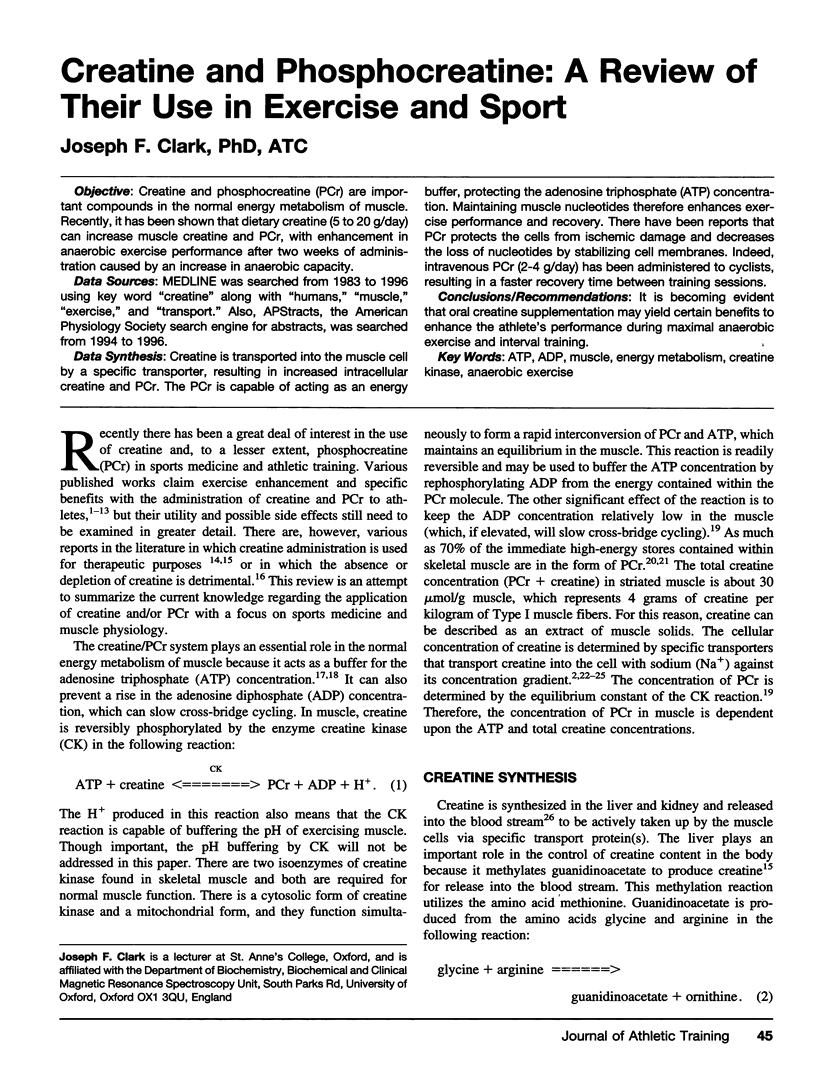
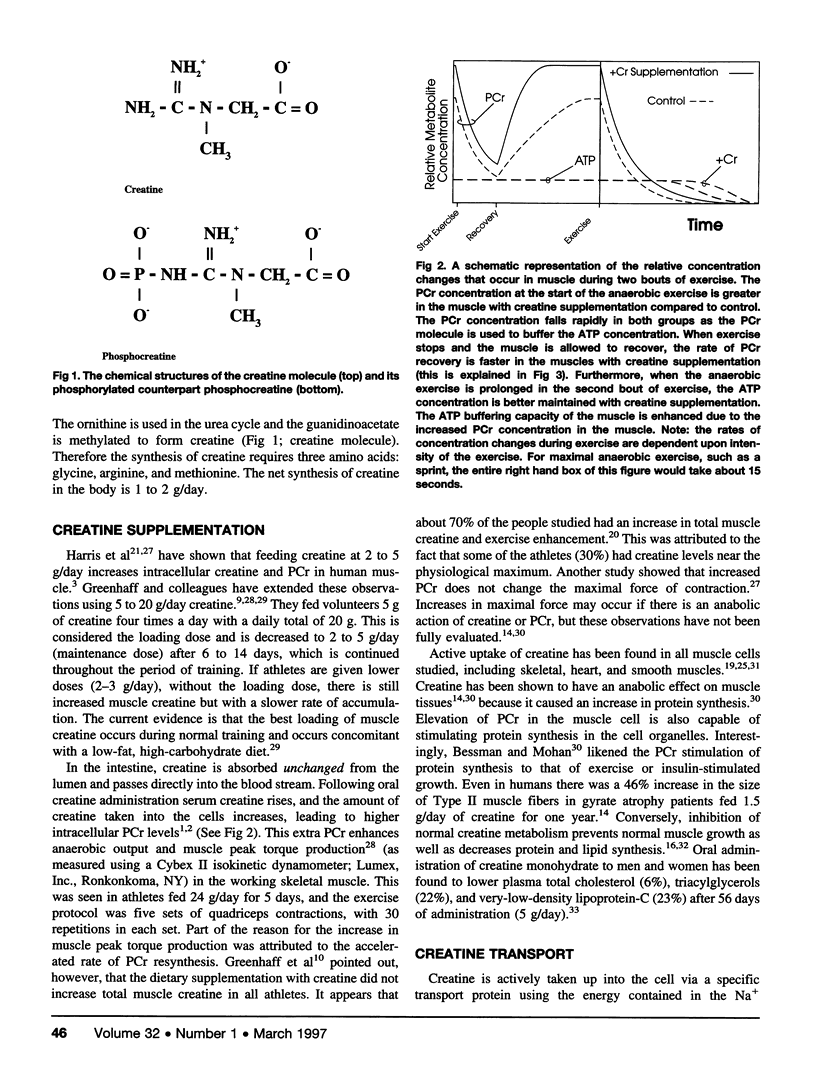
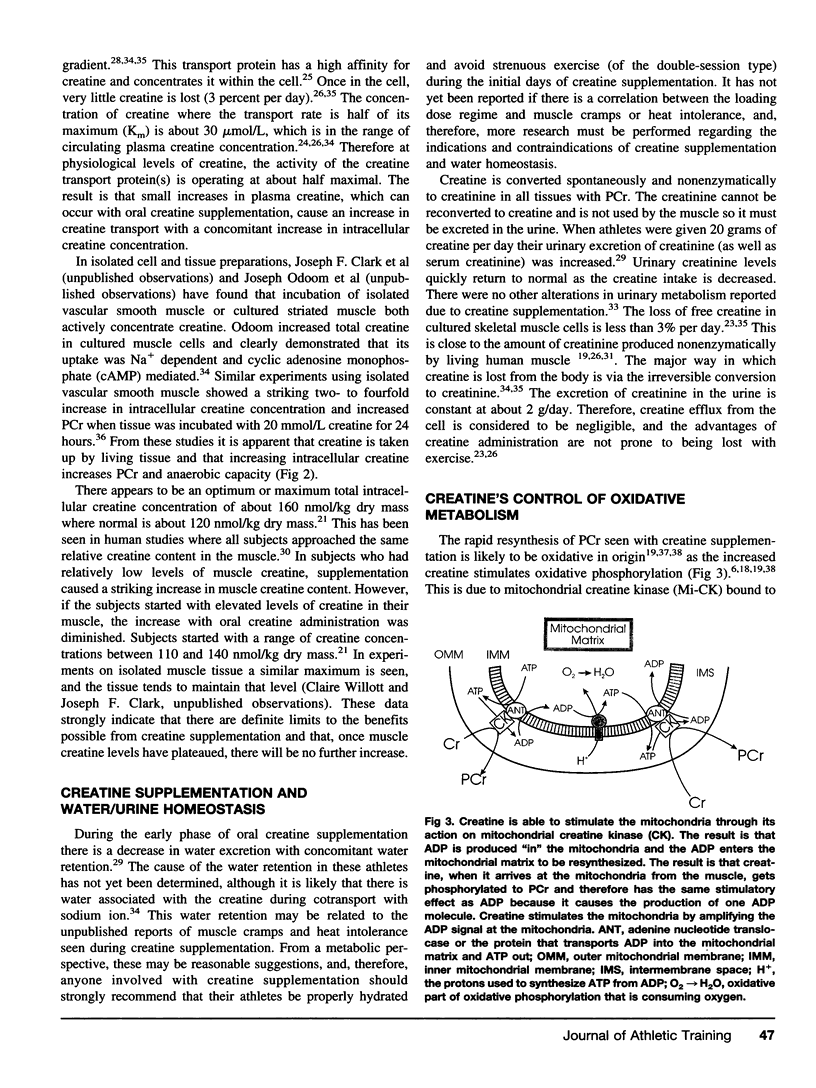
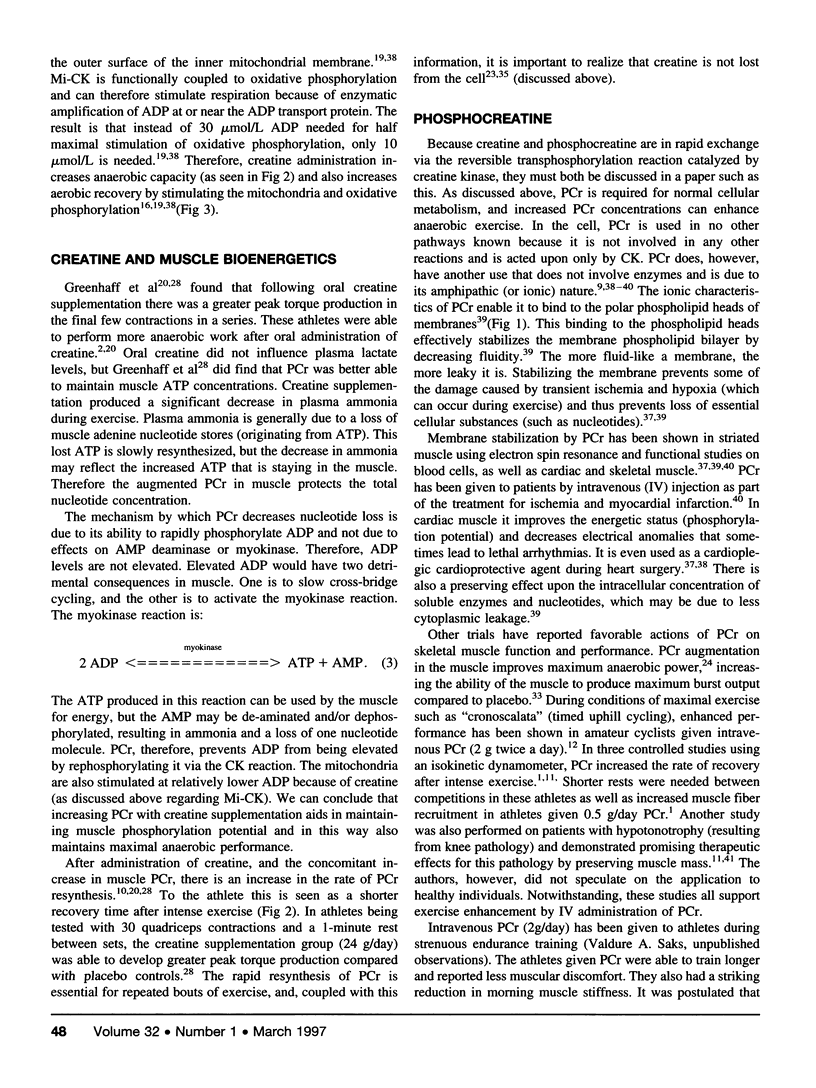
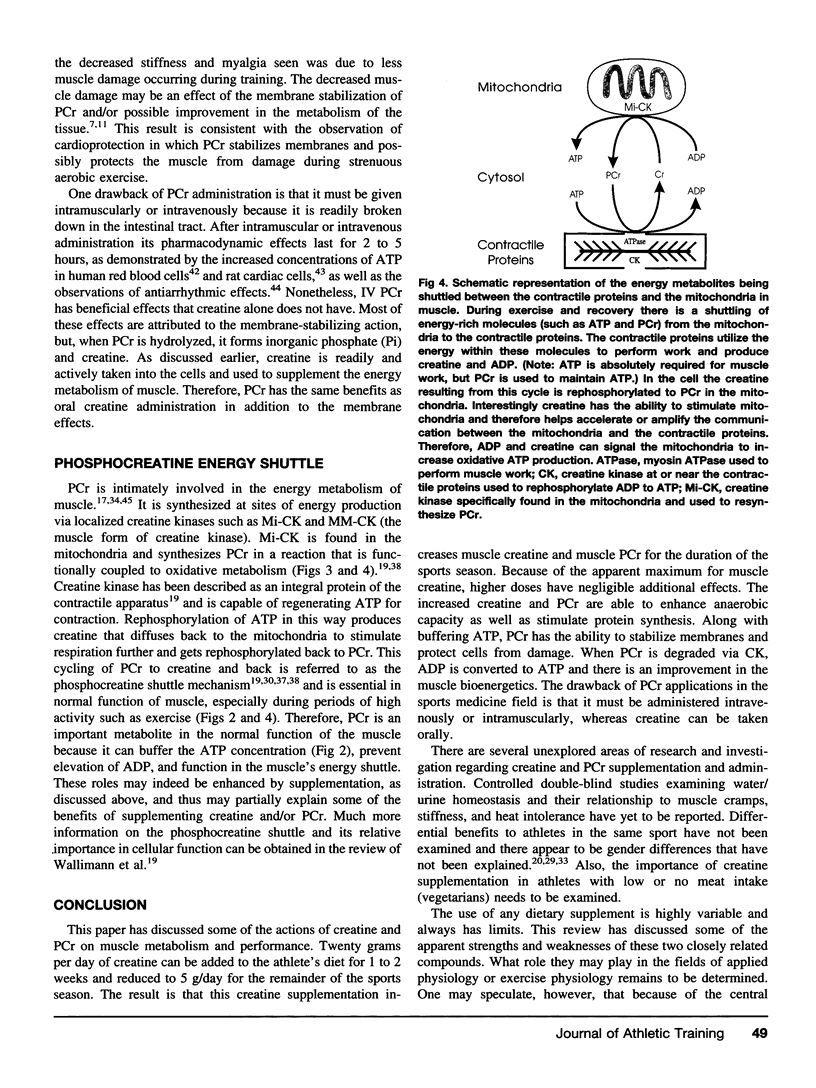
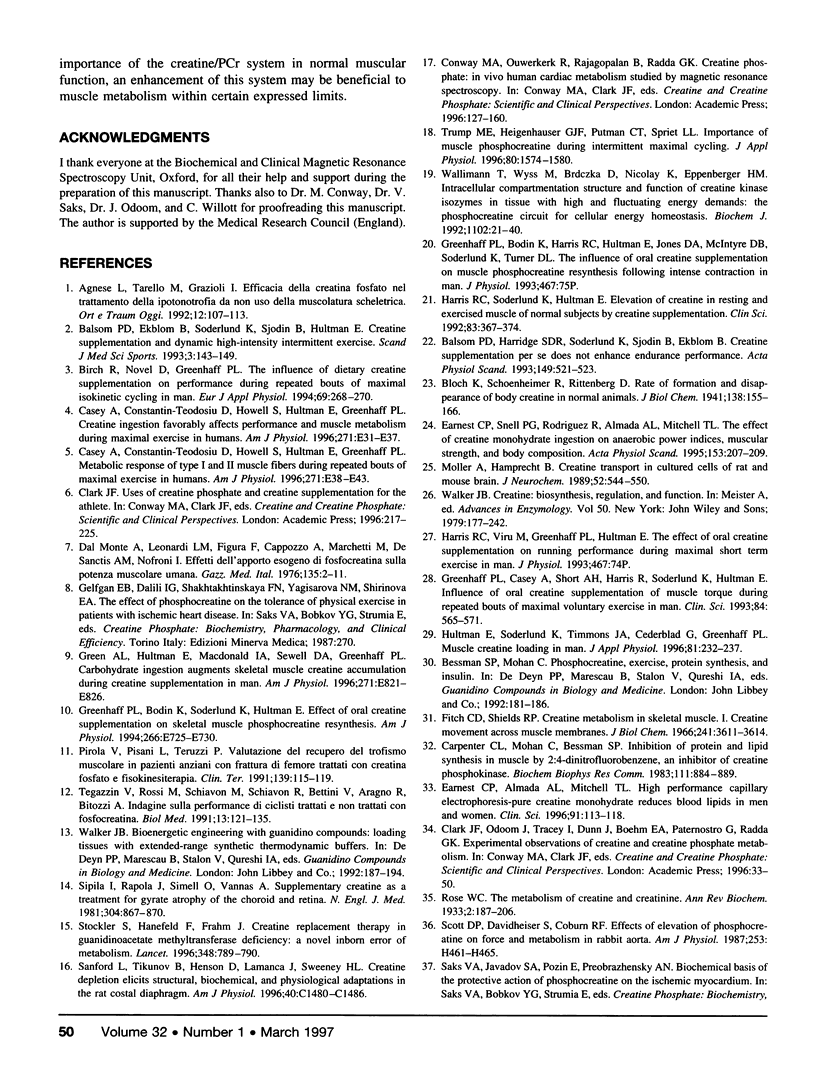
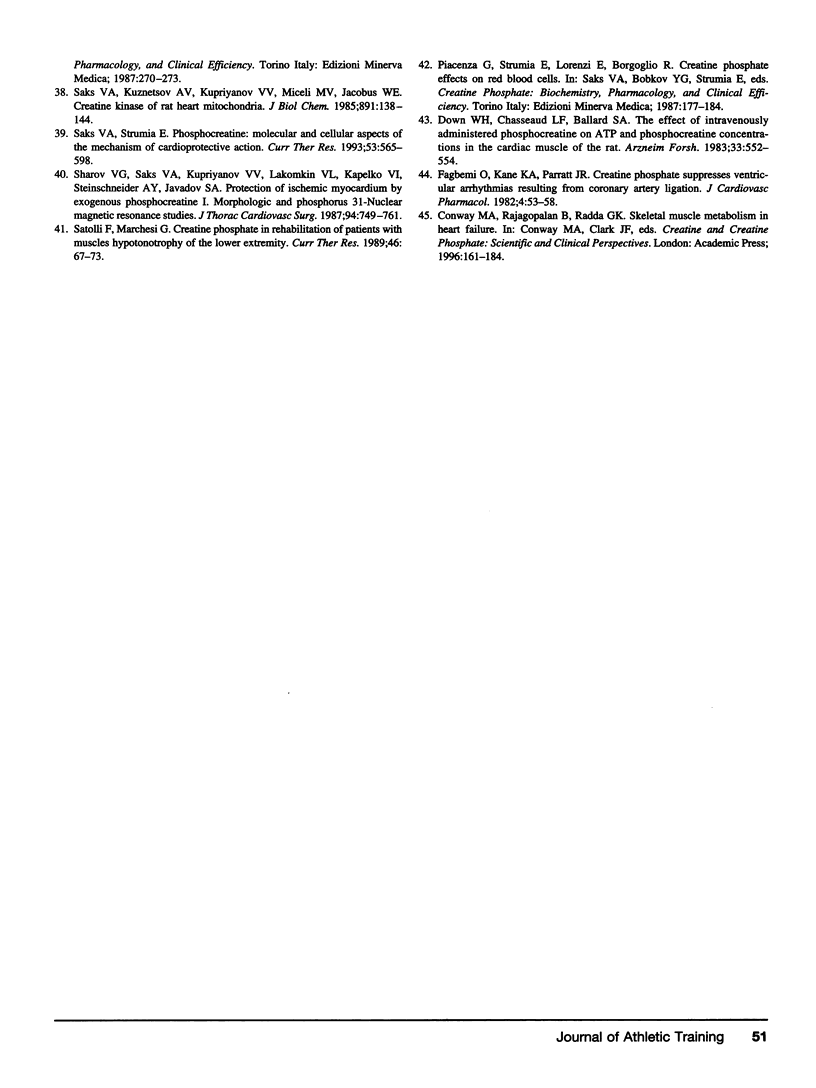
Selected References
These references are in PubMed. This may not be the complete list of references from this article.
- Balsom P. D., Harridge S. D., Söderlund K., Sjödin B., Ekblom B. Creatine supplementation per se does not enhance endurance exercise performance. Acta Physiol Scand. 1993 Dec;149(4):521–523. doi: 10.1111/j.1748-1716.1993.tb09649.x. [DOI] [PubMed] [Google Scholar]
- Birch R., Noble D., Greenhaff P. L. The influence of dietary creatine supplementation on performance during repeated bouts of maximal isokinetic cycling in man. Eur J Appl Physiol Occup Physiol. 1994;69(3):268–276. doi: 10.1007/BF01094800. [DOI] [PubMed] [Google Scholar]
- Carpenter C. L., Mohan C., Bessman S. P. Inhibition of protein and lipid synthesis in muscle by 2,4-dinitrofluorobenzene, an inhibitor of creatine phosphokinase. Biochem Biophys Res Commun. 1983 Mar 29;111(3):884–889. doi: 10.1016/0006-291x(83)91382-7. [DOI] [PubMed] [Google Scholar]
- Casey A., Constantin-Teodosiu D., Howell S., Hultman E., Greenhaff P. L. Creatine ingestion favorably affects performance and muscle metabolism during maximal exercise in humans. Am J Physiol. 1996 Jul;271(1 Pt 1):E31–E37. doi: 10.1152/ajpendo.1996.271.1.E31. [DOI] [PubMed] [Google Scholar]
- Casey A., Constantin-Teodosiu D., Howell S., Hultman E., Greenhaff P. L. Metabolic response of type I and II muscle fibers during repeated bouts of maximal exercise in humans. Am J Physiol. 1996 Jul;271(1 Pt 1):E38–E43. doi: 10.1152/ajpendo.1996.271.1.E38. [DOI] [PubMed] [Google Scholar]
- Down W. H., Chasseaud L. F., Ballard S. A. The effect of intravenously administered phosphocreatine on ATP and phosphocreatine concentrations in the cardiac muscle of the rat. Arzneimittelforschung. 1983;33(4):552–554. [PubMed] [Google Scholar]
- Earnest C. P., Almada A. L., Mitchell T. L. High-performance capillary electrophoresis-pure creatine monohydrate reduces blood lipids in men and women. Clin Sci (Lond) 1996 Jul;91(1):113–118. doi: 10.1042/cs0910113. [DOI] [PubMed] [Google Scholar]
- Earnest C. P., Snell P. G., Rodriguez R., Almada A. L., Mitchell T. L. The effect of creatine monohydrate ingestion on anaerobic power indices, muscular strength and body composition. Acta Physiol Scand. 1995 Feb;153(2):207–209. doi: 10.1111/j.1748-1716.1995.tb09854.x. [DOI] [PubMed] [Google Scholar]
- Fagbemi O., Kane K. A., Parratt J. R. Creatine phosphate suppresses ventricular arrhythmias resulting from coronary artery ligation. J Cardiovasc Pharmacol. 1982 Jan-Feb;4(1):53–58. doi: 10.1097/00005344-198201000-00009. [DOI] [PubMed] [Google Scholar]
- Fitch C. D., Shields R. P. Creatine metabolism in skeletal muscle. I. Creatine movement across muscle membranes. J Biol Chem. 1966 Aug 10;241(15):3611–3614. [PubMed] [Google Scholar]
- Green A. L., Hultman E., Macdonald I. A., Sewell D. A., Greenhaff P. L. Carbohydrate ingestion augments skeletal muscle creatine accumulation during creatine supplementation in humans. Am J Physiol. 1996 Nov;271(5 Pt 1):E821–E826. doi: 10.1152/ajpendo.1996.271.5.E821. [DOI] [PubMed] [Google Scholar]
- Greenhaff P. L., Bodin K., Soderlund K., Hultman E. Effect of oral creatine supplementation on skeletal muscle phosphocreatine resynthesis. Am J Physiol. 1994 May;266(5 Pt 1):E725–E730. doi: 10.1152/ajpendo.1994.266.5.E725. [DOI] [PubMed] [Google Scholar]
- Greenhaff P. L., Casey A., Short A. H., Harris R., Soderlund K., Hultman E. Influence of oral creatine supplementation of muscle torque during repeated bouts of maximal voluntary exercise in man. Clin Sci (Lond) 1993 May;84(5):565–571. doi: 10.1042/cs0840565. [DOI] [PubMed] [Google Scholar]
- Harris R. C., Söderlund K., Hultman E. Elevation of creatine in resting and exercised muscle of normal subjects by creatine supplementation. Clin Sci (Lond) 1992 Sep;83(3):367–374. doi: 10.1042/cs0830367. [DOI] [PubMed] [Google Scholar]
- Hultman E., Söderlund K., Timmons J. A., Cederblad G., Greenhaff P. L. Muscle creatine loading in men. J Appl Physiol (1985) 1996 Jul;81(1):232–237. doi: 10.1152/jappl.1996.81.1.232. [DOI] [PubMed] [Google Scholar]
- Levine S., Tikunov B., Henson D., LaManca J., Sweeney H. L. Creatine depletion elicits structural, biochemical, and physiological adaptations in rat costal diaphragm. Am J Physiol. 1996 Nov;271(5 Pt 1):C1480–C1486. doi: 10.1152/ajpcell.1996.271.5.C1480. [DOI] [PubMed] [Google Scholar]
- Möller A., Hamprecht B. Creatine transport in cultured cells of rat and mouse brain. J Neurochem. 1989 Feb;52(2):544–550. doi: 10.1111/j.1471-4159.1989.tb09154.x. [DOI] [PubMed] [Google Scholar]
- Pirola V., Pisani L., Teruzzi P. Valutazione del recupero del trofismo muscolare in pazienti anziani con frattura di femore trattati con creatina fosfato e fisiokinesiterapia. Clin Ter. 1991 Nov 15;139(3-4):115–119. [PubMed] [Google Scholar]
- Scott D. P., Davidheiser S., Coburn R. F. Effects of elevation of phosphocreatine on force and metabolism in rabbit aorta. Am J Physiol. 1987 Aug;253(2 Pt 2):H461–H465. doi: 10.1152/ajpheart.1987.253.2.H461. [DOI] [PubMed] [Google Scholar]
- Sharov V. G., Saks V. A., Kupriyanov V. V., Lakomkin V. L., Kapelko V. I., Steinschneider AYa, Javadov S. A. Protection of ischemic myocardium by exogenous phosphocreatine. I. Morphologic and phosphorus 31-nuclear magnetic resonance studies. J Thorac Cardiovasc Surg. 1987 Nov;94(5):749–761. [PubMed] [Google Scholar]
- Sipilä I., Rapola J., Simell O., Vannas A. Supplementary creatine as a treatment for gyrate atrophy of the choroid and retina. N Engl J Med. 1981 Apr 9;304(15):867–870. doi: 10.1056/NEJM198104093041503. [DOI] [PubMed] [Google Scholar]
- Stöckler S., Hanefeld F., Frahm J. Creatine replacement therapy in guanidinoacetate methyltransferase deficiency, a novel inborn error of metabolism. Lancet. 1996 Sep 21;348(9030):789–790. doi: 10.1016/s0140-6736(96)04116-5. [DOI] [PubMed] [Google Scholar]
- Trump M. E., Heigenhauser G. J., Putman C. T., Spriet L. L. Importance of muscle phosphocreatine during intermittent maximal cycling. J Appl Physiol (1985) 1996 May;80(5):1574–1580. doi: 10.1152/jappl.1996.80.5.1574. [DOI] [PubMed] [Google Scholar]
- Wallimann T., Wyss M., Brdiczka D., Nicolay K., Eppenberger H. M. Intracellular compartmentation, structure and function of creatine kinase isoenzymes in tissues with high and fluctuating energy demands: the 'phosphocreatine circuit' for cellular energy homeostasis. Biochem J. 1992 Jan 1;281(Pt 1):21–40. doi: 10.1042/bj2810021. [DOI] [PMC free article] [PubMed] [Google Scholar]


